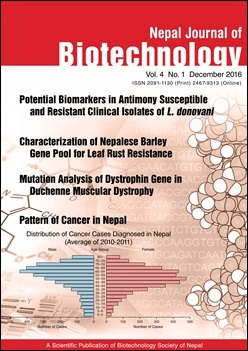Pattern of Cancer in Nepal from 2003 to 2011
DOI:
https://doi.org/10.3126/njb.v4i1.16348Keywords:
Cancer, Nepal, 2003-2011, KathmanduAbstract
Correction: On 15th January 2017, the authors Sunil Kumar Sah and Naval Kishor Yadav were added to the author list.
Cancer is global burden of disease in developed and developing countries. It is one of the main causes of death. The environmental factor and life styles are major causes of cancer.
This hospital based retrospective study was carried out using data retrieved from the register maintained at seven cancer centers. The most common basis of diagnosis were microscopic (histopathological and cytopathological examination). The diagnosis was also based on clinical examination, radiological examination, endoscopy, biochemical and immunological tests.
Most of the cancer cases were diagnosed at BPKMCH (23908) followed by BPKIHS (9668) and BH (5959) and few cases from KCH (518) in 2003 to 2011. The total number of cancer cases were increasing from 2003 to 2011 and it become double in 2011. Out of 75 district of Nepal, more number of cancer cases was found in Kathmandu, Sunsari, Morang, Chitwan, Lalitpur, Jhapa, Kaski, Nawalparasi, Rupendehi and Kavrepalchowk in 2010. Similarly, in 2011 more number of cancer cases was found in Kathmandu, Morang, Jhapa, Sunsari, Chitwan, Lalitpur, Rupendehi, Kaski, Saptari, Bhaktapur. Lung cancer was the common cancer and similarly, other prevalent cancers were cervical, breast, stomach, ovarian and colo-rectum cancer in 2003 to 2011. The common cancers were lung, cervical, breast, stomach, ovarian and colo-rectum. The number of patients is increasing, which may be due to change in life style and lack of education.
Downloads
Downloads
Published
How to Cite
Issue
Section
License
Copyright Notice:
The manuscript submitted to NJB must be an original contribution, not previously published and should not be under consideration for publication elsewhere. When the manuscript is accepted for publication, the authors agree to automatically transfer the copyright of the article to the publisher. It should grant permission to any third party, in advance and in perpetuity, the right to use, reproduce or disseminate your article, according to the NJB copyright and license agreement.
Authors transfer copyright to the publisher as part of a journal publishing agreement but have the rights to: Share their article for Personal Use, Internal Institutional Use and Scholarly Sharing purposes, with the NJB applies the Creative Commons Attribution-NonCommercial CC BY-NC license to all the works we publish after Jun 2020 (Before it was CC BY-NC-ND). Under this license, authors agree to make articles legally available for reuse, without permission or fees, for virtually any non-commercial purpose. Anyone may remix, adapt, and build upon your work non-commercially, and although their new works must also acknowledge you and be non-commercial, they don’t have to license their derivative works on the same terms. More details on CC BY-NC refer to its Licence Deed and Legal Code.






